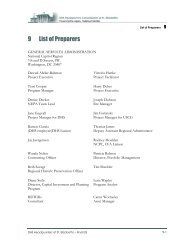395 - GSA Development of St. Elizabeths Campus
395 - GSA Development of St. Elizabeths Campus
395 - GSA Development of St. Elizabeths Campus
- No tags were found...
You also want an ePaper? Increase the reach of your titles
YUMPU automatically turns print PDFs into web optimized ePapers that Google loves.
2 Summary <strong>of</strong> FindingsThe purpose <strong>of</strong> this section is to summarize the general findings <strong>of</strong> the study that are presentedin more detail in Sections 3, 4, and 5 <strong>of</strong> this report.2.1 Existing Travel PatternsExisting travel patterns within the <strong>St</strong>udy Area are affected by the following interwoven and<strong>of</strong>ten competing traffic conditions: (1) regional trips that include work commutes, long-distancethrough trips, and visitors travelling to downtown Washington; (2) local trips that includeshorter travel distances (i.e., trips produced by neighborhoods within Ward 8), as well asmedium and longer travel distances with trip ends located at one <strong>of</strong> several institutional landuses within the <strong>St</strong>udy Area (i.e., the new <strong>St</strong>. <strong>Elizabeths</strong> Hospital on the East <strong>Campus</strong>, AnacostiaNaval Air <strong>St</strong>ation, Bolling Air Force Base, the Naval Research Laboratory, and the National ParkService – National Capital Parks East).2.1.1 Regional Trips or Patterns during Peak PeriodsRegional trips constitute the majority <strong>of</strong> total trips occurring within the <strong>St</strong>udy Area. Travelpatterns are dominated by peak-directional trips that are highly concentrated during the typical3-hour morning and afternoon peak periods. During the morning peak, inbound commutertrips originate in the suburban counties <strong>of</strong> Prince Georges, Charles, and <strong>St</strong>. Mary’s in Marylandand Fairfax and Prince William in Virginia. These trips are generally focused along northboundand westbound routes, with destinations concentrated in the urban core between the Potomacand Anacostia rivers. Conversely, most <strong>of</strong> the trips occurring in the afternoon peak period areoutbound and directed eastbound and southbound. Major highway corridors carrying thehighest traffic volumes include I-295 and South Capitol <strong>St</strong>reet/Frederick Douglass Bridge(northbound in the morning peak & southbound in the afternoon peak); the 11 th <strong>St</strong>reet Bridgesand Suitland Parkway (westbound in the morning peak & eastbound in the afternoon peak).Mass transit trips primarily occur via regional rail lines and the Metrorail, which is operated bythe Washington Area Metropolitan Transit Authority (WMATA). The Green Line Metrorail<strong>of</strong>fers nearby access to <strong>St</strong>. <strong>Elizabeths</strong> through the Anacostia and Congress Heights <strong>St</strong>ations. Theremaining mass transit trips occur via Metrobus routes that follow traffic patterns along theSouth Capitol <strong>St</strong>reet corridor.Other major categories <strong>of</strong> regional travel patterns include pass-by trips that use I-295 as athrough route to bypass downtown Washington DC and connect with the Capital Beltway andvisitors to the nation’s capital whose travel patterns usually mirror those <strong>of</strong> commuters butoccur outside the peak AM and PM time periods.2.1.2 Local Trips or Patterns during Peak PeriodsLocal travel patterns are influenced less by regional commuter trips and more by local land-usefunctions. Medium- and low-density residential neighborhoods that surround <strong>St</strong>. <strong>Elizabeths</strong><strong>Campus</strong> account for a portion <strong>of</strong> the local traffic; these include Bellview and Congress Heightsto the south, Shipley Terrace and Douglass to the east, and Barry Farm and Anacostia to thenorth. In addition, the Anacostia Metro <strong>St</strong>ation on the Green Line serves as a local2-1
















